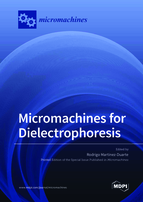Micromachines for Dielectrophoresis
A special issue of Micromachines (ISSN 2072-666X). This special issue belongs to the section "C:Chemistry".
Deadline for manuscript submissions: closed (15 February 2020) | Viewed by 42297
Special Issue Editor
Interests: micromanufacturing; biomanufacturing; carbonaceous materials; electrokinetics; microfluidics; bacteria; composites; healthcare diagnostics; multicultural collaboration
Special Issues, Collections and Topics in MDPI journals
Special Issue Information
Dear Colleagues,
Dielectrophoresis (DEP) remains an effective technique for the label-free identification and manipulation of targeted particles. Applications are numerous, ranging from clinical diagnostics and therapeutics to advanced manufacturing. This Special Issue emphasizes novel techniques and processes to fabricate the next generation of devices that further widens the use of DEP. These innovations include new materials and geometries, volumetric 3D structures, cost-reducing approaches, large-scale manufacturing, and disposable devices. Submissions that assess the effect of process parameters on the performance of DEP devices are particularly encouraged. Submissions integrating modeling and experimentation are preferred.
Dr. Rodrigo Martinez-Duarte
Guest Editor
Manuscript Submission Information
Manuscripts should be submitted online at www.mdpi.com by registering and logging in to this website. Once you are registered, click here to go to the submission form. Manuscripts can be submitted until the deadline. All submissions that pass pre-check are peer-reviewed. Accepted papers will be published continuously in the journal (as soon as accepted) and will be listed together on the special issue website. Research articles, review articles as well as short communications are invited. For planned papers, a title and short abstract (about 100 words) can be sent to the Editorial Office for announcement on this website.
Submitted manuscripts should not have been published previously, nor be under consideration for publication elsewhere (except conference proceedings papers). All manuscripts are thoroughly refereed through a single-blind peer-review process. A guide for authors and other relevant information for submission of manuscripts is available on the Instructions for Authors page. Micromachines is an international peer-reviewed open access monthly journal published by MDPI.
Please visit the Instructions for Authors page before submitting a manuscript. The Article Processing Charge (APC) for publication in this open access journal is 2600 CHF (Swiss Francs). Submitted papers should be well formatted and use good English. Authors may use MDPI's English editing service prior to publication or during author revisions.
Keywords
- microfabrication
- nanofabrication
- materials
- 3D printing
- manufacturing
- electrokinetics
- performance
Related Special Issues
- Micromachines for Dielectrophoresis, 3rd Edition in Micromachines (8 articles)
- Micromachines for Dielectrophoresis, Volume II in Micromachines (14 articles)







